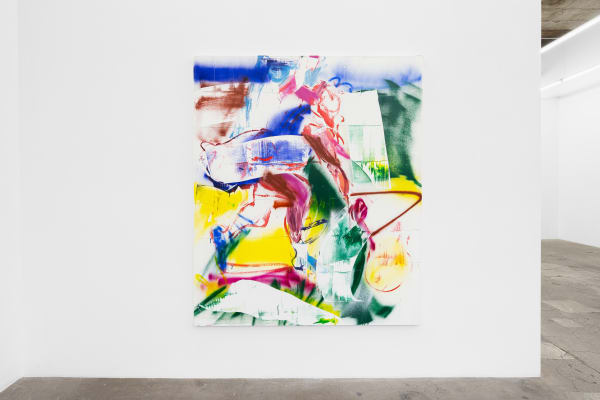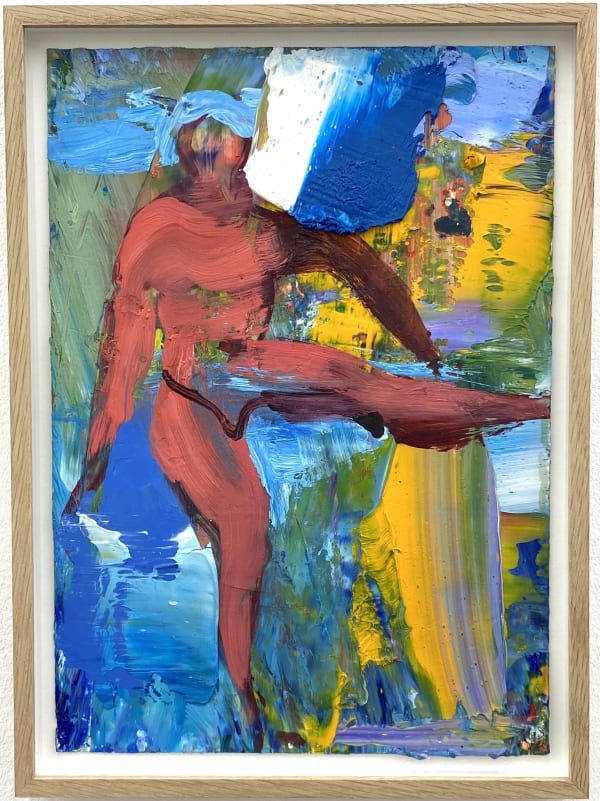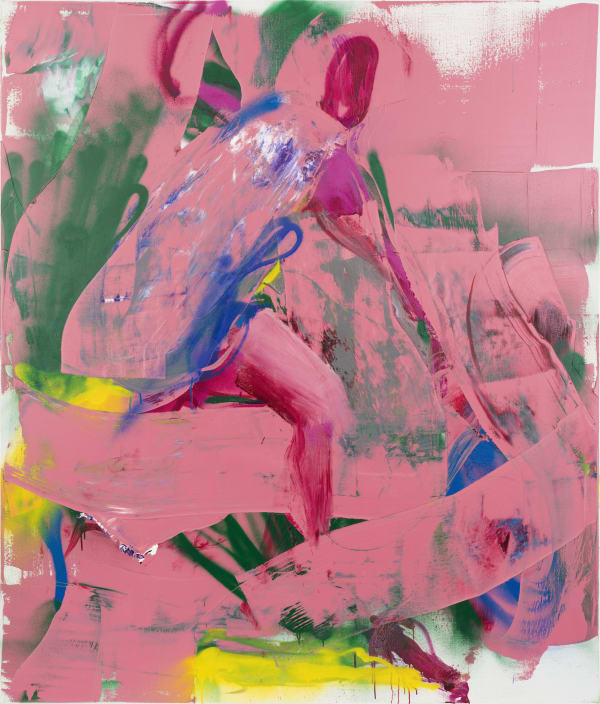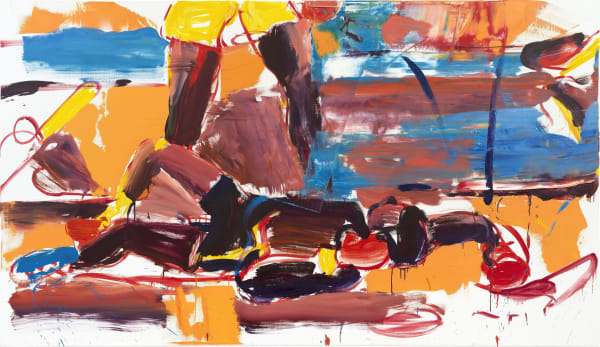Sebastian Hosu: Ballad for Space Lovers
In his latest solo exhibition, emerging artist Sebastian Hosu shows twenty-three new art works on canvas and paper. Sebastian Hosu's expresses himself in figurative painting, yet narration is not his primary interest. Between giving form and dissolvement, within an expressive style Hosu of his own, Hosu creates compositions which have as their primary theme the ability of painting to conjure a strong, a dynamic presence in the pictorial space and before the viewer's eye.
-
 Sebastian Hosu, Picnic by the wayside, 2022
Sebastian Hosu, Picnic by the wayside, 2022 -
 Sebastian Hosu, The Powerpuff Girl, 2022
Sebastian Hosu, The Powerpuff Girl, 2022 -
 Sebastian Hosu, The Possibility of Blue-Ocher and Swimming, 2022
Sebastian Hosu, The Possibility of Blue-Ocher and Swimming, 2022 -
 Sebastian Hosu, Daylight IV, 2022
Sebastian Hosu, Daylight IV, 2022 -
 Sebastian Hosu, The Play, 2022
Sebastian Hosu, The Play, 2022 -
 Sebastian Hosu, Ballad for space lovers, 2022
Sebastian Hosu, Ballad for space lovers, 2022 -
 Sebastian Hosu, Mural I (Daylight), 2022
Sebastian Hosu, Mural I (Daylight), 2022 -
 Sebastian Hosu, Persona III (free in her capsule), 2022
Sebastian Hosu, Persona III (free in her capsule), 2022 -
 Sebastian Hosu, On green floor II, 2022
Sebastian Hosu, On green floor II, 2022 -
 Sebastian Hosu, Picnic by the wayside III, 2022
Sebastian Hosu, Picnic by the wayside III, 2022 -
 Sebastian Hosu, Daylight V, 2022
Sebastian Hosu, Daylight V, 2022 -
 Sebastian Hosu, Bathing III, 2022
Sebastian Hosu, Bathing III, 2022 -
 Sebastian Hosu, Meet Up V, 2022
Sebastian Hosu, Meet Up V, 2022 -
 Sebastian Hosu, The Body Landscape, 2022
Sebastian Hosu, The Body Landscape, 2022 -
 Sebastian Hosu, Untitled, 2022
Sebastian Hosu, Untitled, 2022 -
 Sebastian Hosu, Solaris, 2022
Sebastian Hosu, Solaris, 2022 -
![Sebastian Hosu, Persona II [free in her capsule], 2022](data:image/gif;base64,R0lGODlhAQABAIAAAAAAAP///yH5BAEAAAAALAAAAAABAAEAAAIBRAA7) Sebastian Hosu, Persona II [free in her capsule], 2022
Sebastian Hosu, Persona II [free in her capsule], 2022 -
 Sebastian Hosu, The Powerpuff Girl II, 2022
Sebastian Hosu, The Powerpuff Girl II, 2022 -
 Sebastian Hosu, Ballad for Space Lovers II, 2022
Sebastian Hosu, Ballad for Space Lovers II, 2022 -
 Sebastian Hosu, Female Creation III, 2022
Sebastian Hosu, Female Creation III, 2022 -
![Sebastian Hosu, Persona [free in her capsule], 2021](data:image/gif;base64,R0lGODlhAQABAIAAAAAAAP///yH5BAEAAAAALAAAAAABAAEAAAIBRAA7) Sebastian Hosu, Persona [free in her capsule], 2021
Sebastian Hosu, Persona [free in her capsule], 2021 -
 Sebastian Hosu, Fighting like Cartoon, 2022
Sebastian Hosu, Fighting like Cartoon, 2022 -
 Sebastian Hosu, Persona IV (free in her capsule), 2022
Sebastian Hosu, Persona IV (free in her capsule), 2022
Sebastian Hosu’s works are open spaces for surprises as well as counterpoints to the struggle to break down artistic boundaries. In them, Sebastian Hosu offers his audience a constant conversation of colours. In controlled spirals of escalation, he pushes his materials to a climax of form like a demolition expert. He knows where to hold back, and he knows when an image has reached compositional saturation.
In parts of his images, the artist adeptly switches from honey-sweet melancholy to the cold front of a de-energised surface. There is a constant ebb and flow. He restlessly oscillates from one atmosphere to another. He playfully combines self-control and rebellion with calm. And does so with utmost concentration. Never inattentive. Never unfocused. Even chance plays its part as a catalyst. Even though the onslaught of the brush attack may resemble a throw of a die, there is method to it. Artistic coincidences are inconceivable without their opposite, artistic necessities. Hosu’s paintings are examples of causality in randomness, ran- domness in the causal, necessary randomness and random necessity. At the same time, this artist plays with the inevitable asymmetries and visual balance shifts in the same way the surrealists concentrated their curiosity on the human uncon- scious and made randomness, as a principle of creative unrest, a special focus of their research into the logical patterns of aesthetic argumentation.
Sebastian Hosu lets things run their course. He is not trying to convince an- yone, yet still debates with the authority of one who knows all the tricks. His artistic wisdom is not the know-it-all spoon-fed romantic wisdom of the New Leipzig School. He matured under the heavy brush strokes of the sceptical latest generation, who did not abandon their passion in spite of the pronouncements of the end of painting.
His mission is not limited to the cosy nostalgic gratification of having found something artistically compatible. He wants to move forward. Jackson Pol- lock’s Action Paintings and Max Ernst’s semi-automatic techniques of painting are not enough. He believes these concepts “fell short”. The fascination of tachism and psychic automatism is only apparent to him where they take a rule-based approach. Things often become trivial the closer one gets to an absence of rules. The artist notes that “art is not about justifications, it is first and foremost the will that counts.” Thematically and formally, Hosu’s works strive to be free from puzzles. They are what they are – perfectly tailored events in colour. You see what you see. Autonomous balances of colour at the boundary between the abstract and concrete. Frequently enough there are figurative moments that the artist washes into the painted soup or that emerge from the depths of colour as though derived from Proust’s poetics of involuntary memory.
From the essay „On Pure Painting“ by Christoph Tannert










































![Sebastian Hosu, Persona II [free in her capsule], 2022](https://artlogic-res.cloudinary.com/w_600,c_limit,f_auto,fl_lossy,q_auto/ws-artlogicwebsite0885/usr/images/artworks/main_image/items/b4/b46737133d0743a1badb9342898c49eb/persona-ii-free-in-his-capsule-oil-and-acrylic-spray-on-board-30x20-cm-2022-kopie.jpg)



![Sebastian Hosu, Persona [free in her capsule], 2021](https://artlogic-res.cloudinary.com/w_600,c_limit,f_auto,fl_lossy,q_auto/ws-artlogicwebsite0885/usr/images/artworks/main_image/items/e8/e8160a56e0a5470f894857da68565a10/persona-free-in-his-capsule-100x150-cm-2021-kopie.jpg)


